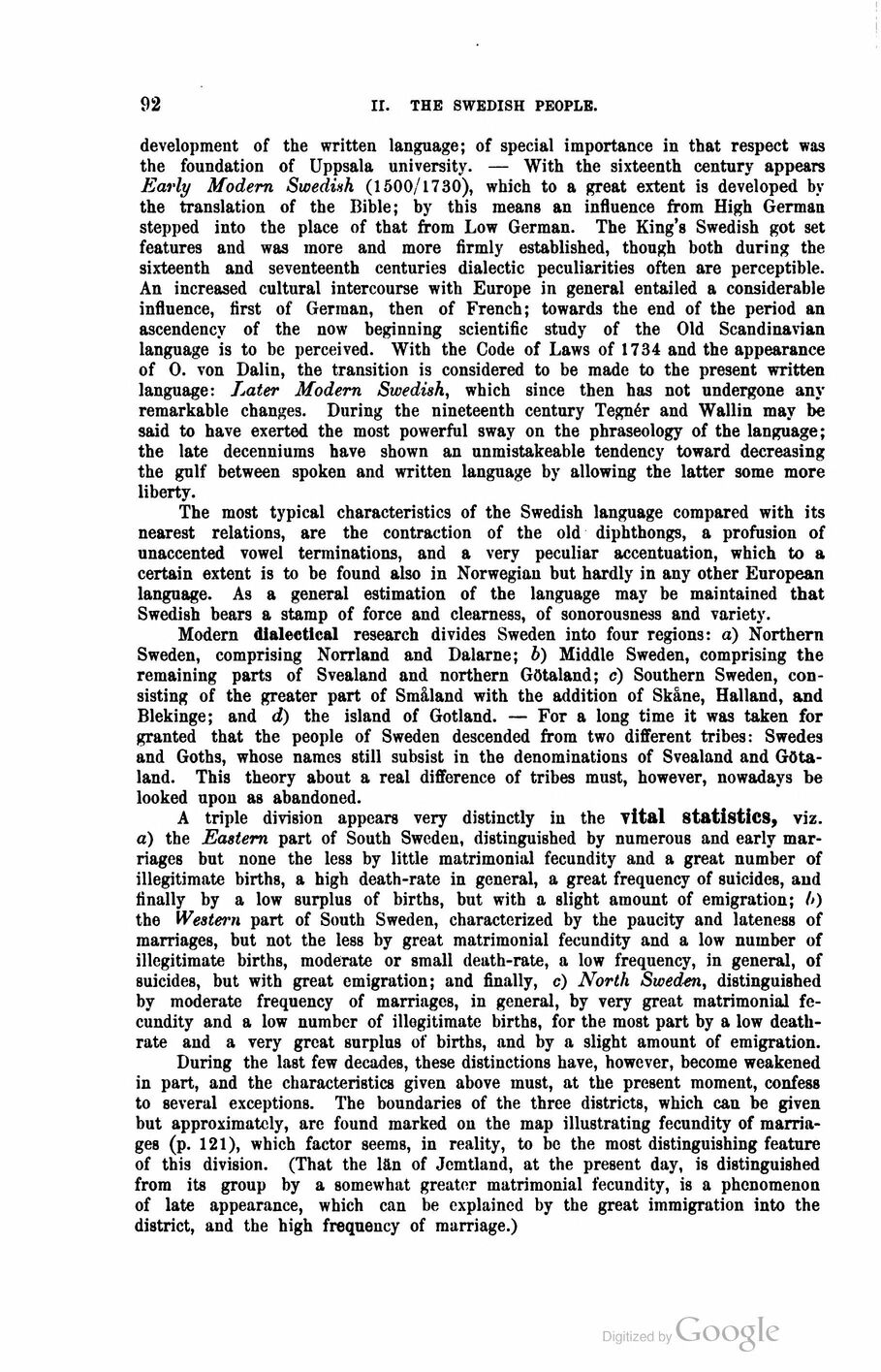
Full resolution (JPEG) - On this page / på denna sida - First part - II. The Swedish People - 2. Demography of Sweden - The Swedish language, by Docent O. von Friesen, Ph. D., Uppsala

<< prev. page << föreg. sida << >> nästa sida >> next page >>
Below is the raw OCR text
from the above scanned image.
Do you see an error? Proofread the page now!
Här nedan syns maskintolkade texten från faksimilbilden ovan.
Ser du något fel? Korrekturläs sidan nu!
This page has never been proofread. / Denna sida har aldrig korrekturlästs.
92
II. TH B SWEDISH PEOPLE.
development of the written language; of special importance in that respect was
the foundation of Uppsala university. — With the sixteenth century appears
Early Modern Swedish (1500/1730), which to a great extent is developed by
the translation of the Bible; by this means an influence from High German
stepped into the place of that from Low German. The King’s Swedish got set
features and was more and more firmly established, though both during the
sixteenth and seventeenth centuries dialectic peculiarities often are perceptible.
An increased cultural intercourse with Europe in general entailed a considerable
influence, first of German, then of French; towards the end of the period an
ascendency of the now beginning scientific study of the Old Scandinavian
language is to be perceived. With the Code of Laws of 1734 and the appearance
of O. von Dalin, the transition is considered to be made to the present written
language: Later Modern Swedish, which since then has not undergone any
remarkable changes. During the nineteenth century Tegnér and Wallin may be
said to have exerted the most powerful sway on the phraseology of the language;
the låte decenniums have shown an unmistakeable tendency toward decreasing
the gulf between spoken and written language by allowing the latter some more
liberty.
The most typical characteristics of the Swedish language compared with its
nearest relations, are the contraction of the old diphthongs, a profusion of
unaccented vowel terminations, and a very peculiar accentuation, which to a
certain extent is to be found also in Norwegian but hardly in any other European
language. As a general estimation of the language may be maintained that
Swedish bears a stamp of force and clearness, of sonorousness and variety.
Modern dialectical research divides Sweden into four regions: a) Northern
Sweden, comprising Norrland and Dalarne; b) Middle Sweden, comprising the
remaining parts of Svealand and northern Götaland; c) Southern Sweden,
consisting of the greater part of Småland with the addition of Skåne, Halland, and
Blekinge; and d) the island of Gotland. — For a long time it was taken for
granted that the people of Sweden descended from two different tribes: Swedes
and Goths, whose names still subsist in the denominations of Svealand and
Götaland. This theory about a real difference of tribes must, however, nowadays be
looked upon as abandoned.
A triple division appears very distinctly in the vital statistics, viz.
a) the Eastern part of South Sweden, distinguished by numerous and early
marriages but none the less by little matrimonial fecundity and a great number of
illegitimate births, a high death-rate in general, a great frequency of suicides, and
finally by a low surplus of births, but with a slight amount of emigration; />)
the Western part of South Sweden, characterized by the paucity and lateness of
marriages, but not the less by great matrimonial fecundity and a low number of
illegitimate births, moderate or small death-rate, a low frequency, in general, of
suicides, but with great emigration; and finally, c) North Sweden, distinguished
by moderate frequency of marriages, in general, by very great matrimonial
fecundity and a low number of illegitimate births, for the most part by a low
death-rate and a very great surplus of births, and by a slight amount of emigration.
During the last few decades, these distinctions have, however, become weakened
in part, and the characteristics given above must, at the present moment, confess
to several exceptions. The boundaries of the three districts, which can be given
but approximately, are found marked on the map illustrating fecundity of
marriages (p. 121), which factor seems, in reality, to be the most distinguishing feature
of this division. (That the län of Jemtland, at the present day, is distinguished
from its group by a somewhat greater matrimonial fecundity, is a phenomenon
of låte appearance, which can be explained by the great immigration into the
district, and the high frequency of marriage.)
<< prev. page << föreg. sida << >> nästa sida >> next page >>